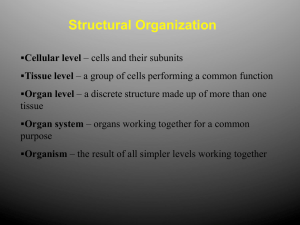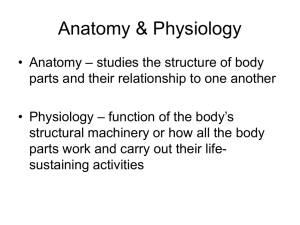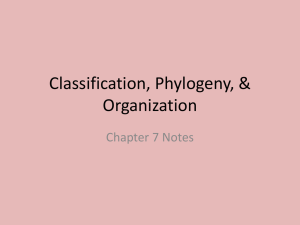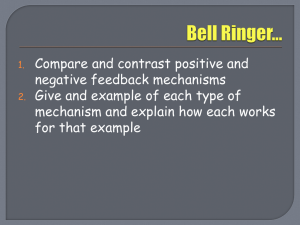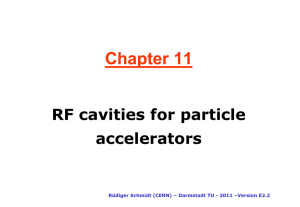RF Cavities
advertisement
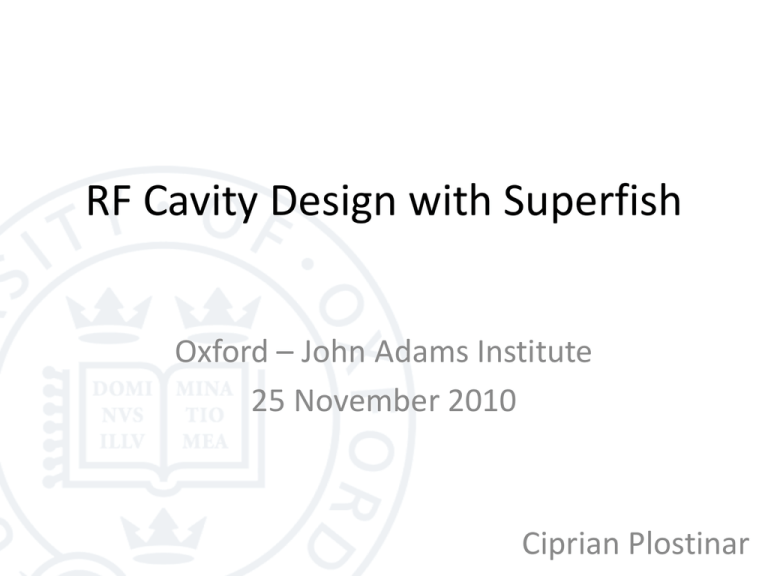
RF Cavity Design with Superfish Oxford – John Adams Institute 25 November 2010 Ciprian Plostinar Overview • RF Cavity Design – Design Criteria – Figures of merit • Introduction to Superfish • Examples: – – – – – Pill-box type cavity DTL type cavity Elliptical cavity ACOL Cavity A possible cavity design for LHeC (hint: your project!) RF Cavity Design • In most particle accelerators (except the betatron), the energy is delivered to the particle by means of a large variety of devices, normally know as cavity resonators. • The ideal cavity is defined as a volume of perfect dielectric limited by infinitely conducting walls (the reality is a bit different). • Hollow cylindrical resonator excited by a radio transmitter - > standing wave -> accelerating fields (the pillbox cavity). RF Cavity Design - Design Criteria • Define the requirements (intended application), RF frequency, NC/SC, voltage, tuning, etc. • General design criteria: – Power Efficiency & RF Properties – Beam Dynamics considerations (control of loss and emittance growth, etc.) – especially true for linacs – Technologies and precisions involved – Tuning procedures (frequency, field profile, stability against perturbations) – Sensitivity to RF errors (phase and amplitude) – Etc. The “Magic Pentagon” of Cavity Design EM Fields Surface Roughness Vacuum Pressure g ssin a g t Ou Particle Loss , etc. Thermal Br r Powe mal Thernsion Expa Surfa ce He ating Mechanical ltip ac tor ea kd ing ow ns ing Parti cle L oss n Tu Mu Beam • The pentagon shows the importance of each design and manufacturing choice • Technologies are interdependent RF Cavity Design - Figures of Merit • The Transit Time Factor, T – While the particle crosses the cavity, the field is also varying -> less acceleration -> the particle sees only a fraction of the peak voltage -> T is a measure of the reduction in energy gain cause by the sinusoidal time variation of the field in the L/2 cavity. 2z L / 2 E (0, z ) cos L/2 L / 2 dz E (0, z ) dz Ez (V/m) Ez (V/m) T Length RF Cavity Design - Figures of Merit • The Quality Factor, Q 2 stored energy 2W U Q0 energyconsum edper period TP0 P0 • To first order, the Q-value will depend on the conductivity of the wall material only • High Q -> narrower bandwidth -> higher amplitudes • But, more difficult to tune, more sensitive to mechanical tolerances (even a slight temperature variation can shift the resonance) • Q is dimensionless and gives only the ratios of energies, and not the real amount of power needed to maintain a certain resonant mode • For resonant frequencies in the range 100 to 1000 MHz, typical values are 10,000 to 50,000 for normal conducting copper cavities; 108 to 1010 for superconducting cavities. RF Cavity Design - Figures of Merit Shunt Impedance - a measure of the effectiveness of producing an axial voltage V0 for a given power dissipated 2 V0 rs P0 – Effective Shunt Impedance per unit length 2 r ( E0T ) ZT L P0 / L 2 – Typical values of ZT2 for normal conducting linacs is 30 to 50 M/m. The shunt impedance is not relevant for superconducting cavities. RF Cavity Design - Figures of Merit • r/Q • measures the efficiency of acceleration per unit of stored energy at a given frequency r (V0T ) Q U 2 • It is a function only of the cavity geometry and is independent of the surface properties that determine the power losses. RF Cavity Design - Figures of Merit • The Kilpatrick limit • High Field -> Electric breakdown • Maximum achievable field is limited 2 8.5 / Ek k f 1.64E e RF Cavity Design - Figures of Merit • Slightly different story for SC cavities (see example 4): – r/Q (characteristic impedance) – G (Geometric Factor - the measure of energy loss in the metal wall for a given surface resistance) – Epeak/Eacc - field emissions limit (Eacc limit) – Bpeak/Eacc – quench limit (sc breakdown) – Higher Order Modes – manage and suppress HOM (e.g.: dipole modes can degrade the beam -> suppression scheme using HOM couplers) – Kcc – Cell to cell coupling – Multicell cavities: Field Flatness – Optimise geometry to increase both r/Q and G resulting in less stored energy and less wall loss at a given gradient (low cryogenic losses) – Optimise geometry to reduce Epeak/Eacc and Bpeak/Eacc – Find optimum Kcc. (e.g.: a small aperture increases r/Q and G (!), but reduces Kcc. A small Kcc increases the sensitivity of the field profile to cell frequency errors.) Introduction to Poisson Superfish • You will need a laptop running Windows. If you don’t have one, please email us in advance and we will try to get one for you. If you have Linux/MacOS install VMWare/Wine. • Please download and install Poisson Superfish. To do this go to the following address and follow the instructions: http://laacg1.lanl.gov/laacg/services/download_sf.phtml • Please download the example files to your computer from the JAI website. • An extensive documentation can be found in the Superfish home directory (usually C:/LANL). – Have a look at the SFCODES.DOC file. Table VI-4 explains how the object geometry is defined in Superfish (page 157). – For a list of Superfish variables, see SFINTRO.doc, Table III-3 (page 76) • For any questions, email Emmanuel (emmanuel.tsesmelis@cern.ch) or Ciprian (ciprian.plostinar@stfc.ac.uk). Good luck! Introduction to Poisson Superfish • Poisson and Superfish are the main solver programs in a collection of programs from LANL for calculating static magnetic and electric fields and radio-frequency electromagnetic fields in either 2-D Cartesian coordinates or axially symmetric cylindrical coordinates. • Finite Element Method Solvers: - Automesh – generates the mesh (always the first program to run) - Fish – RF solver - Cfish – version of Fish that uses complex variables for the rf fields, permittivity, and permeability. - Poisson – magnetostatic and electrostatic field solver - Pandira – another static field solver (can handle permanent magnets) - SFO, SF7 – postprocessing - Autofish – combines Automesh, Fish and SFO - DTLfish, DTLCells, CCLfish, CCLcells, CDTfish, ELLfish, ELLCAV, MDTfish, RFQfish, SCCfish – for tuning specific cavity types. - Kilpat, Force, WSFPlot, etc. Poisson Superfish Examples - A Pillbox cavity • The simplest RF cavity -> Resonant frequency independent of the cell length -> Example: a 40 MHz cavity (PS2) would have a diameter of ~ 5.7 m -> In the picture, CERN 88 MHz For the accelerating mode (TM010), the resonant wavelength is: D x1 x1 2.40483 x1 - first root of the zero-th order Bessel function J0 (x) Poisson Superfish Examples - A Pillbox cavity Superfish input file Poisson Superfish Examples - A DTL-type cavity • Drift Tube Linac Cavity CERN Linac4 DTL prototype Special Superfish input geometry f D/2 Rc L/2 Drift tube g/2 g/2 Ro or Rdo F or Fd Beam axis d/2 Rb Ri or Rdi Rb Poisson Superfish Examples - A DTL-type cavity Solution Superfish input file Geometry file Poisson Superfish Examples - An elliptical cavity • Often used in superconducting applications INFN & CEA 704 MHz elliptical SC cavities FEq,L w 2aD R Special Superfish input geometry 2bI D FEq,R L FEq/2 2aI I Elliptical segments with aspect ratios (aD/bD)L and (aD/bD)R Nominal end of cell Elliptical segments with aspect ratios (aI/bI)L and (aI/bI)R 2bD Cell midplane D/2 w L/2 FI Rb,L Rb Rb,R L/2 L/2 TR T2 Rb,2 Beam axis Beam axis Poisson Superfish Examples - An elliptical cavity Superfish input file Geometry file Solution 1 Cell Solution 5 Cell Cavity Poisson Superfish Examples - The ACOL Cavity • A 9.5 MHz cavity for bunch rotation in the CERN Antiproton Collector. • Low Frequency Pillbox-type cavities are challenging because of their large dimensions • Alternatives: – Ferrite Dominated Cavities (Bias current in the ferrite -> Small cavity & Tuning, Typical gap voltage ~ 10 kV, Long beam line space required for higher voltages) – High gradient magnetic alloy loaded cavity (70 kV) – Oil loaded, Ceramic gap loaded cavity Poisson Superfish Examples - The ACOL Cavity • Air-core RF cavity: large capacitive electrode -> lower frequency Different models ACOL Cavity Initial Design ACOL Cavity Final Model (Built) Poisson Superfish Examples - The ACOL Cavity - - Pillbox Cavity, - 2.5/1.64m - f= 91.8 MHz - Pillbox Cavity, - with drift nose - 2.5/1.64m - f= 56 MHz - Pillbox Cavity, - with one electrode - 2.5/1.64m - f= 12 MHz - Pillbox Cavity, - with two electrodes - 2.5/1.64m - f= 9.23 MHz Poisson Superfish Examples - LHeC Cavities • Two options: – Linac-Ring – Ring-Ring • • • • • • • 60 GeV Energy Energy lost/turn @60 GeV? Losses due to synchrotron radiation? (for the design beam current) Total RF Voltage needed? Total RF Power Needed? Number of cavities? Choice of frequency: 400 MHz or 721 MHz Poisson Superfish Examples - LHeC Cavities • Example: Possible 400 MHz Cavity – Like the LHC 400 MHz RF – 4-cell cavity – 4 cavities/SC Cryomodule configuration 4 Cell Cavity 1 Cell Poisson Superfish Examples - LHeC Cavities • Example: Possible 721.4 MHz Cavity – SPL-like cavities (slightly smaller) – 5-cell cavity 5 Cell Cavity 1 Cell Now, use your imagination!


